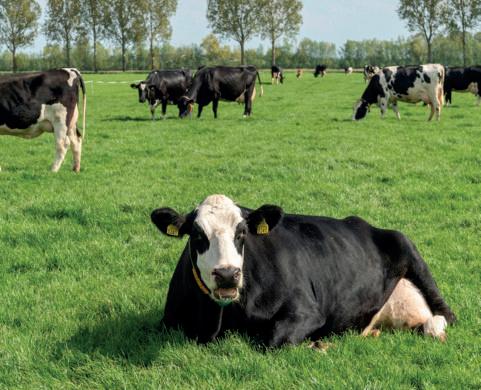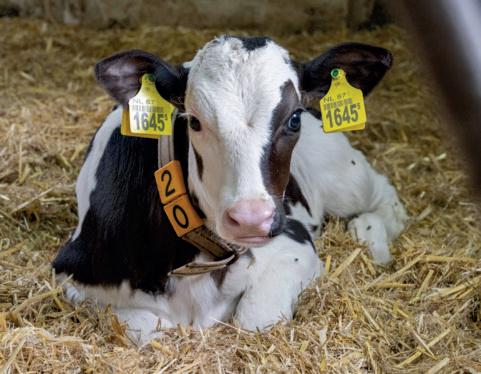






At the end of January, a dairy farmer called the Veekijker for more information about the necropsy result of one of his calves. The calf was one day old and, despite starting well after the birth, died suddenly. The necropsy report described a haemorrhagic inflammation of the abomasum and intestine caused by Clostridium spp. The necropsy report also noted that iron pigments were present in the epithelial cells of the abomasum.
The farmer stated that he had been administering an iron bolus to his calves shortly after birth for about six weeks. He had started doing so after being told by the calf rearer that his calves often had low haemoglobin levels and that administering iron supplements would therefore be wise. No additional diagnostics were carried out to determine haemoglobin levels in the blood before giving the iron bolus. Since he had started giving iron boluses to the calves, three of them had suddenly died, including the animal that had been sent in for pathological examination.
The calves on the farm are fed fresh cow’s milk; powdered milk is not given. Cow’s milk generally contains less iron than powdered milk, in which iron is often added. Bacteria such as Clostridium spp. use iron and can multiply rapidly when sufficient iron is present. It therefore seems possible that administering the iron boluses created a more favourable environment for the Clostridium bacteria that were already present. The toxins produced by these bacteria can be lethal to the calf. The livestock farmer decided to stop administering iron boluses immediately. The advice was furthermore to look critically at the dry period of dairy cows in order to get strong and vital calves, and to consider switching to milk powder. In a follow-up contact with the farmer a few weeks later, he stated that no calves had died since the administration of iron boluses was stopped.
In February, a veterinarian contacted the Veekijker with questions about the results of the necropsy and blood tests done on a three-month-old calf. The calf had exhibited muscular weakness after going outside with its mother after the period in the cowshed. A veterinarian in the practice recognised the symptoms of white muscle disease. It was a calf on a large suckler cow farms. A second calf at this farm exhibited the same symptoms. The blood work for this calf showed that the levels of copper, selenium and zinc were low. The vitamin E and beta carotene concentrations were also severely lowered. The necropsy revealed acute degeneration of the skeletal muscles and cardiac muscle. Copper deficiency in the liver was also noted. This post-mortem diagnostic picture is consistent with white muscle disease, and the low selenium and vitamin E levels in the blood back up that diagnosis.
The livestock farmer was advised to check that the various age groups were getting the correct minerals and to give them supplements if necessary. Fresh grass is a good source of vitamin E and beta carotene.


Royal GD has been responsible for animal health monitoring in the Netherlands since 2002, in close collaboration with the veterinary sectors, the business community, the Ministry of Agriculture, Fisheries, Food Security and Nature, veterinarians and farmers. The information used for the surveillance programme is gathered in various ways, whereby the initiative comes in part from vets and farmers, and partly from Royal GD. This information is fully interpreted to achieve the objectives of the surveillance programme – rapid identification of health issues on the one hand and monitoring trends and developments on the other. Together, we team up for animal health, in the interests of animals, their owners and society at large.
The mortality of cattle aged over one year at dairy farms has increased since the fourth quarter of 2023 (Figure 1). The increase is related to the BTV-3 outbreak in 2023 and 2024. Adult cattle at suckler cow farms also had higher mortality because of BT. Additionally, mortality was higher than expected for both ear-tagged and non-ear-tagged calves in the third and fourth quarters of 2024 at dairy, suckler and veal calf farms (only ear-tagged calves).
Research into the impact of BTV-3 on cattle health showed that dairy cattle farms with BTV-3 infections in 2023 had reduced fertility in 2024. Claw health was no different from the period before bluetongue. However, Claw health data only comes from the approximately 1,900 participants in Digiklauw. In Digiklauw, claw care providers only score claw abnormalities and not typical bluetongue symptoms such as stiffness and swelling of the coronary bands. Farms with little or no BTV-3 infection in 2023 but that probably were infected in 2024 had somewhat reduced udder health and higher antibiotic use in 2024 than before the bluetongue period.
Cattle deaths aged >1 year at dairy farms annually
Since early January, the Veekijker has received numerous reports of calves with neurological symptoms, ranging from abnormal behaviour (“stupid” or “slow” calves and opithotonus or “stargazing”) to nervous signs like twitching and falling over. The first reports were about young calves on dairy farms, followed by calves on veal calf farms. Many of these animals deteriorated or could no longer fend for themselves and were euthanised. Pathological examination showed congenital brain abnormalities such as hydrocephalus and hydranencephaly (absence of the
Following up on an earlier report from monitoring about abnormal calves of the bull American Expeditie, it has been noted that abnormal calves have been born on a new farm. The calving ease bull used on this farm turned out to be an offspring of bull
cerebral hemispheres). In the first quarter of 2025 in particular, this diagnosis was made more often than in previous periods. Brain abnormalities were also diagnosed more frequently in aborted foetuses. Additional investigations showed bluetongue virus and/or antibodies against BTV in several animals. BTV-8 has been described as causing congenital brain abnormalities if the mother is infected in early gestation. This has not yet been described for BTV-3. A pilot study has been started because of this striking increase.
American Expeditie. The calves were found to have very specific abnormalities such as large ears, skin defects below the auditory canal with an open connection to the pharynx, and mouth parts (tooth elements and a lip) below the auditory canal.
VETERINARY DISEASES
Implementing Regulation (EU) 2018/1882 of Animal Health Regulation (AHR) 2016/429 (category A disease)
Lumpy Skin Disease (LSD) Viral infection. The Netherlands is officially disease-free.
Foot and Mouth Disease (FMD)
Viral infection. The Netherlands has been officially disease-free since 2001.
D, E No infections ever detected.
D, E No infections detected.
Implementing Regulation (EU) 2018/1882 of Animal Health Regulation (AHR) 2016/429 (categories B to E)
Bluetongue (BT)
Bovine genital campylobacteriosis
Bluetongue serotype 3 outbreak in the Netherlands since September 2023 (see §3.2.1).
Bacterium.
The Netherlands has been disease-free since 2009. Monitoring of AI and embryo stations and of animals for export.
Bovine Viral Diarrhoea (BVD) Viral infection.
Control measures are compulsory for dairy farms but voluntary on beef cattle farms.
C, D, E New infections are not suspected. Studies entitled ‘Impact of BTV-3 and vaccination’ and ‘Farm prevalence of BTV-12’ have been published.
D, E Campylobacter fetus spp. veneralis not detected.
C, D, E The status* of 91.3 per cent of dairy farms is ‘BVD-free’ or ‘BVD not suspected’.
The status of 20.1 per cent of all non-dairy farms is favourable (BVD-free or BVD not suspected).
* The BVD status as determined according to the GD programme.
Brucellosis (zoonosis, infection through animal contact or inadequately prepared food)
Bacterium.
The Netherlands has been officially diseasefree since 1999. Monitoring via antibody testing of blood samples from aborting cows.
Enzootic bovine leukosis Viral infection.
The Netherlands has been officially diseasefree since 1999. Monitoring via antibody testing of bulk milk and blood samples from slaughtered cattle.
Epizootic Haemorrhagic Disease (EHD) Viral infection. Detected since 2022 in cattle in Europe (Spain, Italy, Portugal and France).
Infectious Bovine Rhinotracheitis (IBR) Viral infection. Control measures are compulsory for dairy farms but voluntary on beef cattle farms.
Anthrax (zoonosis, infection through contact with animals)
Bacterium. Not detected in the Netherlands since 1994. Monitoring through blood smears from fallen stock.
B, D, E No infections detected.
C, D, E No infections detected.
D, E No infections detected. Vaccine has temporary authorisation In the Netherlands.
C, D, E The status of 83.1 per cent of dairy farms is ‘IBR-free’ or ‘IBR not suspected’.
The status of 21.8 per cent of all non-dairy farms was favourable (IBR-free or IBR not suspected).
D, E No infections detected.
VETERINARY
Implementing Regulation (EU) 2018/1882 of Animal Health Regulation (AHR) 2016/429 (categories B to E)
Paratuberculosis
Bacterium.
In the Netherlands, the control programme is compulsory for dairy farms. 99 per cent take part.
Rabies
(zoonosis, infection through bites or scratches)
Bovine tuberculosis (TB) (zoonosis, infection through animal contact or inadequately prepared food)
Viral infection.
The Netherlands has been officially diseasefree since 2012 (an illegally imported dog).
Bacterium.
The Netherlands has been officially diseasefree since 1999. Monitoring of slaughtered cattle.
Trichomonas Parasite.
The Netherlands has been disease-free since 2009. Monitoring of AI and embryo stations and of animals for export.
E The status of 83 per cent of dairy farms is A (‘not suspected’) in the PPN (Paratuberculosis Programme Netherlands) or 6 in the IPP (Intensive Paratuberculosis Programme).
B, D, E No infections detected.
B, D, E No infections detected.
C, D, E Tritrichomonas foetus not detected.
Q fever (zoonosis, infection through dust or inadequately prepared food)
Bacterium.
In the Netherlands, this is a different strain to the one found on goat farms with no established relationship to human illness.
From the first quarter of 2023 onwards, this is once again part of the aborter pathology protocol.
E Two infections detected in aborted foetuses.
Article 3a.1 Notification of zoonoses and disease symptoms, ‘Rules for Animal Husbandry’ from the Dutch Animals Act Leptospirosis
(zoonosis, infection through animal contact or inadequately prepared food)
Bacterium.
Control measures are compulsory for dairy farms but voluntary on beef cattle farms.
Listeriosis
(zoonosis, infection through inadequately prepared food)
Salmonellosis
(zoonosis, infection through animal contact or inadequately prepared food)
Yersiniosis
(zoonosis, infection through animal contact or inadequately prepared food)
Bacterium. Infections have occasionally been detected in cattle.
Bacterium.
Control measures are compulsory for dairy farms but voluntary on beef cattle farms.
Bacterium.
Infections detected occasionally in cattle, mostly in aborted foetuses.
- The status of 98.1 per cent of dairy farms is ‘leptospirosis-free’.
The status of 30.6 per cent of non-dairy farms is ‘leptospirosis-free’
More animals are arriving with a leptospirosis status poorer than ‘free’ than in the previous quarter.
No new leptospirosis infections.
- Nine infections detected in cattle or aborted foetuses presented for necropsy.
- The bulk milk results of 96.8 per cent of dairy farms are favourable (nationwide programme).
- No infections detected.
Royal GD
P.O. Box 9, 7400 AA Deventer
T. +31 (0)88 20 25 575
info@gdanimalhealth.com www.gdanimalhealth.com
VETERINARY DISEASES
Regulation (EC) no. 999/2001
Bovine Spongiform Encephalopathy (BSE) Prion infection. The OIE status for the Netherlands is ‘negligible risk’. Monitoring has not revealed any further cases since 2010 (88 cases overall from 1997 to 2009).
Other infectious diseases in cattle
Malignant Catarrhal Fever (MCF) Viral infection. There are occasional cases in the Netherlands of infection with type 2 ovine herpes virus.
Liver fluke Parasite.
Liver flukes are endemic in the Netherlands, particularly in wetland areas.
Neosporosis Parasite. In the Netherlands, this is an important infectious cause of abortion in cows.
Tick-borne diseases
External parasite that can transmit infections. Ticks infected with Babesia divergens, Anaplasma phagocytophilum and Mycoplasma wenyonii can be found in the Netherlands.



- No infections detected.
Table continuation
- Two infections confirmed upon necropsy.
- Infections were detected at 49 farms and in seven animals presented for necropsy.
- No infections detected in aborted foetuses submitted for necropsy.
- No further examinations possible.


